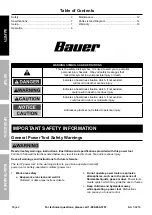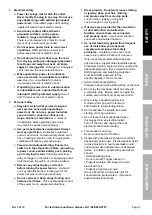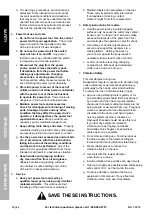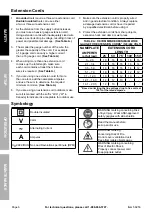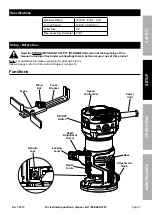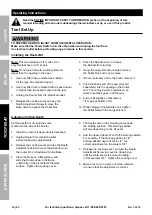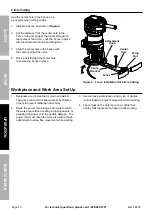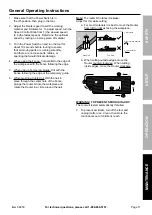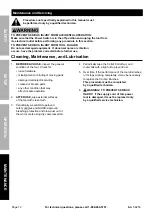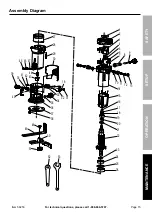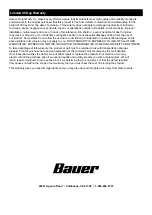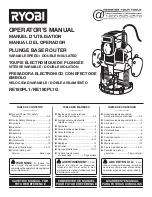
Page 3
For technical questions, please call 1-888-866-5797.
Item 58253
SA
FE
TY
OP
ERA
TI
O
N
MAINT
ENANC
E
SE
TUP
2.
Electrical safety
a.
Power tool plugs must match the outlet.
Never modify the plug in any way. Do not use
any adapter plugs with earthed (grounded)
power tools.
Unmodified plugs and matching
outlets will reduce risk of electric shock.
b.
Avoid body contact with earthed or
grounded surfaces, such as pipes,
radiators, ranges and refrigerators.
There is an increased risk of electric shock
if your body is earthed or grounded.
c.
Do not expose power tools to rain or wet
conditions.
Water entering a power tool
will increase the risk of electric shock.
d.
Do not abuse the cord. Never use the cord
for carrying, pulling or unplugging the power
tool. Keep cord away from heat, oil, sharp
edges or moving parts.
Damaged or entangled
cords increase the risk of electric shock.
e.
When operating a power tool outdoors,
use an extension cord suitable for outdoor
use.
Use of a cord suitable for outdoor
use reduces the risk of electric shock.
f.
If operating a power tool in a damp location
is unavoidable, use a ground fault circuit
interrupter (GFCI) protected supply.
Use of
a GFCI reduces the risk of electric shock.
3.
Personal safety
a.
Stay alert, watch what you are doing and
use common sense when operating a
power tool. Do not use a power tool while
you are tired or under the influence of
drugs, alcohol or medication.
A moment
of inattention while operating power tools
may result in serious personal injury.
b.
Use personal protective equipment. Always
wear eye protection.
Protective equipment
such as dust mask, non-skid safety shoes, hard
hat, or hearing protection used for appropriate
conditions will reduce personal injuries.
c.
Prevent unintentional starting. Ensure the
switch is in the off-position before connecting
to power source and/or battery pack, picking
up or carrying the tool.
Carrying power tools
with your finger on the switch or energizing power
tools that have the switch on invites accidents.
d.
Remove any adjusting key or wrench
before turning the power tool on.
A wrench
or a key left attached to a rotating part of the
power tool may result in personal injury.
e.
Do not overreach. Keep proper footing and
balance at all times.
This enables better control
of the power tool in unexpected situations.
f.
Dress properly. Do not wear loose clothing
or jewelry. Keep your hair, clothing
and gloves away from moving parts.
Loose clothes, jewelry or long hair
can be caught in moving parts.
g.
If devices are provided for the connection
of dust extraction and collection
facilities, ensure these are connected
and properly used.
Use of dust collection
can reduce dust-related hazards.
h.
Do not let familiarity gained from frequent
use of tools allow you to become
complacent and ignore tool safety
principles.
A careless action can cause
severe injury within a fraction of a second.
i. Only use safety equipment that has been
approved by an appropriate standards agency.
Unapproved safety equipment may not provide
adequate protection. Eye protection must be
ANSI-approved and breathing protection
must be NIOSH-approved for the
specific hazards in the work area.
j. Avoid unintentional starting.
Prepare to begin work before turning on the tool.
k. Do not lay the tool down until it has come to
a complete stop. Moving parts can grab the
surface and pull the tool out of your control.
l. When using a handheld power tool,
maintain a firm grip on the tool with
both hands to resist starting torque.
m. Do not depress the spindle lock when
starting or during operation.
n. Do not leave the tool unattended when
it is plugged into an electrical outlet.
Turn off the tool, and unplug it from its
electrical outlet before leaving.
o. This product is not a toy.
Keep it out of reach of children.
p. People with pacemakers should consult their
physician(s) before use. Electromagnetic fields
in close proximity to heart pacemaker could
cause pacemaker interference or pacemaker
failure. In addition, people with pacemakers
should:
• Avoid operating alone.
• Do not use with Trigger locked on.
• Properly maintain and inspect to avoid
electrical shock.
• Properly ground power cord.
Ground Fault Circuit Interrupter (GFCI)
should also be implemented – it prevents
sustained electrical shock.


